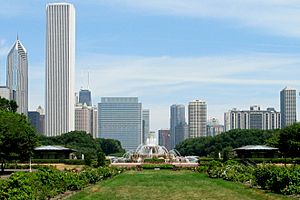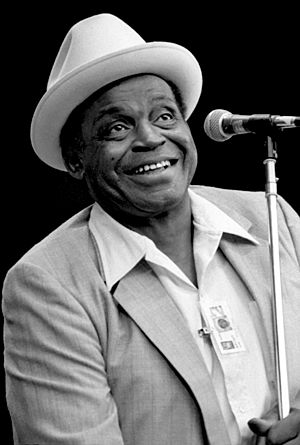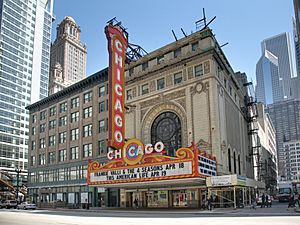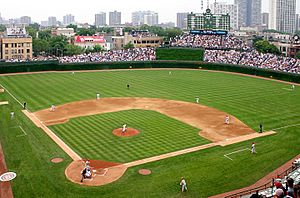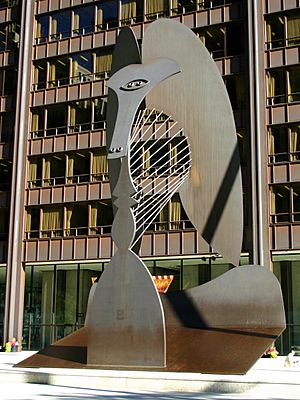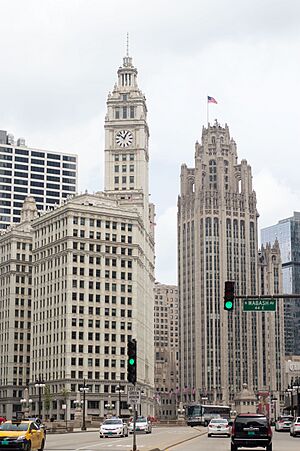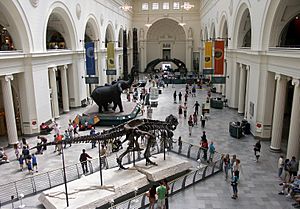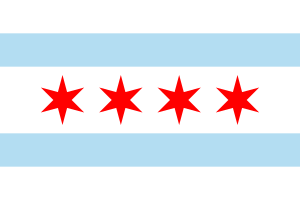Culture of Chicago facts for kids
The city of Chicago, Illinois is famous for its amazing culture! It's where many types of performing arts were created or became very popular. These include improvisational comedy, house music, blues, hip hop, gospel, jazz, and soul.
Chicago is also well-known for its special building styles, like the Chicago School and Prairie School architecture. The city has a strong tradition of classical music, popular music, dance, and other performing arts. These traditions come from different cultures, brought by people from all over the world who live in Chicago.
And don't forget the food! Chicago is famous for yummy dishes like deep-dish pizza, the Chicago-style hot dog, and the Italian beef sandwich.
Contents
Delicious Food in Chicago
Chicago has many unique foods that show off its history and the different groups of people who live there. One of the most famous is its deep-dish pizza. People say this thick, cheesy pizza started at a place called Pizzeria Uno. Chicago also has a popular thin-crust pizza. Many famous chefs have opened restaurants here, like Grant Achatz and Rick Bayless.
In 2003, a magazine called Robb Report named Chicago the best city for dining in the country. In 2008, it was even called the "Tastiest City"!
Chicago's Special Dishes
Here are some of Chicago's most popular local foods:
- The Chicago-style hot dog is a must-try! It's a beef hot dog on a poppy-seed bun. It's topped with yellow mustard, chopped onion, sliced tomato, bright green sweet-pickle relish, sport peppers, a dill pickle spear, and celery salt. But remember, never any ketchup!
- Chicago-style pizza is a deep-dish pizza with a tall crust and lots of cheese. The chunky tomato sauce goes on top of the cheese, not under it. There's also "stuffed pizza," which has even more cheese and a second, thinner crust on top. Another popular type is "tavern style" thin-crust pizza. It's very crispy and cut into squares, not wedges.
- The Italian beef is a tasty sandwich. It has thinly sliced roast beef cooked in a flavorful broth. This "gravy" has Italian spices. The beef is served on an Italian roll soaked in the meat juices. You can add cheese, like provolone or mozzarella. A "combo" adds grilled Italian sausage. Italian beef sandwiches are often topped with sweet peppers or spicy giardiniera.
Other unique Chicago dishes include:
- A francheezie is a special hot dog. It's wrapped in bacon and deep-fried. It can also be stuffed or topped with cheese.
- Maxwell Street Polish is a Polish sausage. It's made with beef, pork, garlic, and other spices. It's served on a bun with grilled onions.
- The jibarito is a sandwich from Chicago's Puerto Rican community. Instead of bread, it uses two pieces of fried, flattened plantain with meat or chicken and other toppings inside.
- Chicken Vesuvio is an Italian-American dish. It has chicken, potatoes, celery, and carrots. They are cooked with garlic, oregano, white wine, and olive oil. Then they are baked until the chicken skin is crispy.
- Shrimp DeJonghe is a casserole. It has peeled shrimp covered in soft, garlicky bread crumbs with sherry.
- The mother-in-law is a tamale on a hot dog bun, topped with chili.
- Chicago also has its own style of tamale. These are made from cornmeal and wrapped in paper. You can often find them at hot dog stands.
- Gyros are very popular in Chicago. While some places make their own, Chicago is where mass-produced gyros started.
- Flaming saganaki became famous in the Greektown neighborhood. A square of cheese is fried in a small pan. Then, a splash of brandy is added and it's lit on fire! Waiters traditionally shout "Opa!" when they serve it.
- A pizza puff is a deep-fried dough pocket. It's filled with cheese, tomato sauce, and other pizza toppings like sausage. You can find them at some hot dog restaurants in Chicago.
- A pepper and egg sandwich has scrambled eggs and grilled bell peppers. It's served on French bread. Italian immigrants in Chicago first ate it during Lent.
- The big baby is a double cheeseburger. It has cheese between the patties, ketchup, mustard, and pickles underneath. Grilled onions are on top.
- The breaded-steak sandwich is popular in the Bridgeport neighborhood. It's a flattened, breaded, and fried beef cut. It's served on an Italian roll with marinara sauce. You can add mozzarella cheese or green peppers.
- Pork chop sandwiches are popular on the South Side. They are served with the bone in, mustard, and grilled onions.
- The gym shoe (or Jim Shoe) is a submarine sandwich. It combines corned beef, gyros, and either roast beef or Italian beef.
- Aquarium-smoked barbecue is also popular. This includes rib tips and hot links. This barbecue is cooked in a special indoor smoker with glass sides.
- Mild sauce is a special topping. It's made with barbecue sauce, ketchup, and hot sauce. Sometimes it has honey or sugar. It's used on fried chicken and other foods. It became popular at fast food places in Chicago's African-American community.
- Giardiniera is a spicy mix of chopped, pickled vegetables in oil. It's a popular topping in Chicago, especially on Italian beef sandwiches. Chicago-style giardiniera has very finely chopped vegetables and uses oil, not vinegar.
- Popcorn from Garrett Popcorn Shops is famous. Their "Garrett Mix" combines cheddar cheese popcorn and caramel popcorn.
- Atomic cake has layers of banana, yellow, and chocolate cake. It has banana, strawberry, and fudge fillings.
- Chicago Brick ice cream is a Neapolitan-style ice cream. It has orange sherbet, vanilla, and caramel flavors.
Chicago's Restaurant Scene
Chicago has many restaurants that show off its different ethnic neighborhoods. You can find Chinatown on the South Side, and Swedish/Nordic Andersonville on North Clark street. There's Greektown on Halsted Street, and Little Italy on Taylor Street. The South Asian community on Devon Avenue has many Pakistani and Indian eateries.
The Mexican neighborhoods of Pilsen and Little Village have many places to eat. These range from small taquerías to full restaurants. You can find Middle Eastern food along Lawrence Avenue. Polish cuisine is popular along Milwaukee Avenue. Many Vietnamese restaurants are in the Argyle Street district in Uptown.
In 2019, the Chicago Tribune newspaper highlighted five "iconic black restaurants." These family-run places had some of the best food in the city. They included Harold's Chicken Shack (started 1950), Lem's Bar-B-Q (started 1954), Uncle Remus Saucy Fried Chicken (started 1963), Taurus Flavors (started 1966), and Old Fashioned Donuts (started 1972). Chicago also has many fried-shrimp shacks.
Besides ethnic food and fast food, Chicago has many steakhouses. It also has fancy dining places with all kinds of food. Some famous spots include Frontera Grill, a gourmet Mexican restaurant by chef Rick Bayless. There's also Jean Joho's Everest, a new-French restaurant on the top floor of the Chicago Stock Exchange building.
Chicago is also known for its "molecular gastronomy." This is a way of cooking that uses science to create new textures and flavors. Chefs like Grant Achatz of Alinea are famous for this.
Taste of Chicago is a huge food festival held every July in Grant Park. It has booths from many Chicago restaurants and live music.
Brewing in Chicago
Chicago has a long history of making beer. While large breweries mostly stopped during Prohibition, today the city has many smaller breweries and brewpubs. In 2018, Chicago had more breweries than any other city in the country, with 167! Some of these are Half Acre and Revolution Brewing.
The two biggest breweries in Chicago are Lagunitas and Goose Island. Goose Island started in Chicago in 1988.
Chicago has yearly beer events like Illinois Craft Beer Week and the Festival of Barrel-Aged Beers.
Distilled Spirits in Chicago
Jeppson's Malört is a special drink in Chicago. It's a Swedish-style liqueur flavored with wormwood. It's known for its bitter taste. You can find it in some Chicago bars and stores, but rarely anywhere else. The company started in Chicago in the 1930s. In 2019, Malört production moved back to Chicago.
Koval was the first distillery to open in Chicago since Prohibition. It started in 2008. Koval makes many different spirits.
Music in Chicago
Chicago has made huge contributions to the world of music. It's famous for Chicago blues, Chicago soul, jazz, gospel, indie rock, hip hop, industrial music, and punk rock. In the 1980s, Chicago house music started here. This led to the development of techno music in Detroit.
Chicago artists have been very important in R&B and soul music. Famous R&B and soul artists from Chicago include Sam Cooke, Curtis Mayfield, The Impressions, and Jennifer Hudson.
Many famous musicians came from Chicago blues. These include Howlin' Wolf, Muddy Waters, Willie Dixon, Buddy Guy, and Koko Taylor.
Jazz musicians who lived in Chicago include Jelly Roll Morton, Benny Goodman, and Dinah Washington. Chicago is also home to the Association for the Advancement of Creative Musicians. This group helped create a new style of jazz called avant-garde jazz.
The hip hop scene in Chicago is also very important. Major artists like Kanye West, Chance the Rapper, Twista, and Common are from Chicago.
The rock band Chicago was named after the city. Their original name was the Chicago Transit Authority. Other popular rock bands from Chicago include Styx, Cheap Trick, and Survivor.
Chicago has also had a lively folk music scene, especially in the 1960s and 1970s. John Prine and Steve Goodman were well-known folk singer-songwriters.
In the late 1970s, the local band The Shoes helped start indie rock. Later, 1980s and 1990s alternative bands like Ministry, Veruca Salt, and The Smashing Pumpkins came from Chicago. Today, bands like Wilco and Disturbed are also based here.
Chicago is also known for indie rockers like OK Go and Andrew Bird. The city is home to many independent music labels like Thrill Jockey.
A few punk rock bands are based in Chicago. Some famous ones are Naked Raygun and Screeching Weasel. Many of these bands started at places like Metro and the Empty Bottle.
Chicago is also called the "birthplace of American Industrial Music." Many industrial bands started here. The city was home to the record label Wax Trax! Records, which had bands like Ministry and Front 242.
The Chicago Symphony Orchestra is one of the oldest and most respected orchestras in the country. It is known worldwide for its tours and recordings.
Chicago also has a growing modern classical music scene. Composers like Augusta Read Thomas are from here.
Chicago's history has inspired many songs. After the Great Chicago Fire in 1871, a Chicago resident wrote the hymn "It Is Well With My Soul."
Chicago hosts many free music festivals every year. These include the Chicago Blues Festival, the Chicago Jazz Festival, and the Grant Park Music Festival. There are also ticketed festivals like Lollapalooza and Pitchfork Music Festival.
Performing Arts in Chicago
Chicago is a major center for theater. It's where modern improvisational comedy was born! The city has two famous comedy groups: The Second City and iO Theater. Improv itself was invented at the University of Chicago in the 1950s.
Since they started, the Goodman Theatre and Steppenwolf Theatre Company have helped many actors, directors, and writers. They are now famous worldwide. Many other theaters, from small "black box" spaces to large downtown theaters like the Chicago Theatre, show all kinds of plays and musicals. This includes touring shows and new works. The Chicago Shakespeare Theater and Lookingglass Theatre Company have won special Tony Awards.
Broadway In Chicago brings touring Broadway shows and musical previews to the city. This creates many jobs and helps the local economy. You can also see plays in Polish at the historic Gateway Theatre.
The Lyric Opera of Chicago, started in 1954, performs in the Civic Opera House. This beautiful building was built in 1929.
The Lithuanian Opera Company of Chicago was started by Lithuanian Chicagoans in 1956. They perform operas in Lithuanian.
The Joffrey Ballet is based in Chicago. Other dance groups in the city include Hubbard Street Dance Chicago and Gus Giordano Jazz Dance Chicago.
Chicago's Uptown neighborhood is said to be the birthplace of Slam Poetry. This is a type of spoken word poetry that mixes hip hop, drama, jazz, and lyrics.
Sports in Chicago
Chicago is one of only a few cities that have major league teams in baseball, football, basketball, and hockey. Chicago is also one of only four cities with two baseball teams. And it's the only one that has had the same two teams since 1901!
The Chicago White Sox baseball team plays in the American League. They won the World Series in 1906, 1917, and 2005. They play at Guaranteed Rate Field on the South Side.
The Chicago Cubs baseball team plays in the National League. They won the World Series in 1907, 1908, and 2016. They play at Wrigley Field on the North Side. The area around the stadium is called "Wrigleyville."
The Chicago Bears football team plays in the National Football League. They play at Soldier Field. The Bears have won nine American Football championships, including Super Bowl XX.
The Chicago Bulls basketball team is one of the most famous teams in the world. This is thanks to their amazing success in the 1990s with Michael Jordan. They won six NBA titles! The Bulls play at the United Center.
The Chicago Blackhawks hockey team also plays at the United Center. They are one of the "Original Six" teams, started in 1926. They have won six Stanley Cups.
The Chicago Fire soccer team plays in Major League Soccer. They have won one league title and four US Open Cups since 1997. They play their home games at Soldier Field.
The Chicago Red Stars of the National Women's Soccer League play at SeatGeek Stadium. The team started in 2009.
The Chicago Sky of the Women's National Basketball Association play at the Wintrust Arena. They have made it to the WNBA playoffs several times.
The Chicago Wolves hockey team plays in the American Hockey League. They play at the Allstate Arena in nearby Rosemont. The Wolves have won four league championships.
The Northwestern Wildcats college football team plays in nearby Evanston. Chicago also has several college basketball teams, including the DePaul Blue Demons and the Loyola Ramblers.
Minor league baseball teams near Chicago include the Kane County Cougars and the Chicago Dogs.
The Chicago Bandits, a women's professional softball team, play at Rosemont Stadium.
The Windy City Bulls are an NBA G League team. They are connected to the Chicago Bulls and play in Hoffman Estates.
Chicago has several roller derby leagues, like the Windy City Rollers.
The Chicago Swans are the Australian rules football club in the city.
Rugby teams in Chicago include the Chicago Lions.
There are two places for auto racing near Chicago, both in Joliet. Chicagoland Speedway hosts NASCAR races.
Every autumn, thousands of runners compete in the Chicago Marathon.
In most of the U.S., softball is played with a 12-inch ball. But in Chicago, 16-inch softball is more popular!
Chicago hosted the 1959 Pan American Games and the Gay Games VII in 2006. The city tried to host the 2016 Summer Olympics, but it wasn't chosen.
Visual Arts in Chicago
Chicago has a lively art community. Many modern art galleries are in the River North and West Loop neighborhoods. Chicago art has always been very unique and not easily influenced by trends from other places.
Chicago has a strong tradition of figurative surrealism. This style shows strange or dream-like images. Artists like Ivan Albright and Ed Paschke are examples. In the late 1960s, artists called the Chicago Imagists made unusual paintings.
This unique style also appeared in Chicago's street photography. Famous photographers like Harry Callahan and Vivian Maier worked here.
Chicago has a program for public artworks. This means you can see large art pieces around the city.
Chicago is home to many large outdoor artworks by famous artists. These include the Chicago Picasso sculpture, Miró's Chicago, and Flamingo by Alexander Calder. You can also see Cloud Gate (the "Bean") by Anish Kapoor, and Crown Fountain by Jaume Plensa.
Chicago's Architecture
Most of downtown Chicago was destroyed by the Great Chicago Fire in 1871. Almost all the buildings there now were built after that fire. One exception is the Chicago Water Tower.
Around the early 1900s, Chicago was key in developing the skyscraper. Architects like Louis Sullivan led this movement with the Chicago School design. Famous tall buildings from this time include the Rookery Building, the Auditorium Building, and the Wrigley Building.
In the 1940s, a new "Second Chicago School" of architecture started. This came from the work of Ludwig Mies van der Rohe. He designed buildings like S. R. Crown Hall.
The tallest buildings in Chicago are Willis Tower, Trump Tower, and the St. Regis Chicago. The Willis Tower was once called Sears Tower. It was the tallest building in the world from 1973 to 1998. It is now the second-tallest building in the United States.
Other important modern skyscrapers in Chicago include Marina City and Lake Point Tower.
The Prairie School of architecture began in Chicago. The city has many buildings by Frank Lloyd Wright and other Prairie School architects. Examples include Robie House.
The Pullman District was the first planned industrial community in the U.S.
Some neighborhoods have many "Chicago bungalow" houses. These single-family brick homes were built mostly between 1910 and 1940.
Literature in Chicago
Early writers connected to Chicago include Theodore Drieser and Eugene Field. Poets like Gwendolyn Brooks and Carl Sandburg are also from Chicago. Other famous writers linked to the city's literary history include Nelson Algren, Saul Bellow, Ernest Hemingway, and Richard Wright.
Fun Public Attractions
Chicago has many popular public attractions. These include the Museum of Science and Industry, the Field Museum of Natural History, Adler Planetarium, Shedd Aquarium, and Lincoln Park Zoo. You can also visit the Chicago History Museum, Millennium Park, and Navy Pier.
The city has several art museums. The two largest are the Art Institute and the Museum of Contemporary Art.
Every August, Chicago hosts the Chicago Air & Water Show. This is a free show on the shores of Lake Michigan.
Chicago's Flag and City Symbol
The flag of Chicago has four red stars and two blue stripes on a white background. The stars stand for important events in the city's history. These include the start of Fort Dearborn in 1803, the Great Chicago Fire in 1871, and two big world's fairs in 1893 and 1933. The blue stripes represent the North and South branches of the Chicago River. The flag is very popular in the city. People love its bold design and how it shows their city pride.
Less known is the Chicago municipal device. This symbol looks like the letter Y inside a circle. It represents where the North, South, and main branches of the Chicago River meet. You can see this symbol in different places around the city, like on the sign of the Chicago Theatre.


